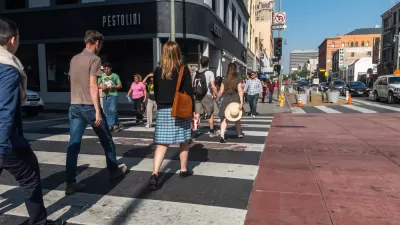Dan Rosenfeld looks at two recent projects in L.A. that incorporate public art components and finds that "investments in public art may provide the highest financial returns of any funds committed to an aspect of a transit project."
While the "soft" benefits of public art, such as education, inspiration, and aesthetic beauty are readily acknowledged, the marketing and income generating potential of such pieces are less well understood. Rosenfeld uses two recent examples from Los Angeles - the mixed-use Wilshire Vermont Station and The District 7 headquarters of the California Department of Transportation (Caltrans) - to support his argument for the financial benefits of public art.
At Wilshire Vermont Station, images of murals painted by environmental artist April Greiman, "have been
printed in dozens of publications, including newspapers and national and
local business magazines. The images are routinely used by the local
transit agency as emblems of the entire transit system, and the site is
frequently host to press events and photo shoots. For example, the mayor
of Los Angeles often uses the murals as a backdrop during televised
announcements."
"The private marketing benefits, in
real-dollar terms, of this modest public art investment are almost
inestimably high. The continuing visibility, publicity, and brand
identification that public art provided for the project were purchased
for less than one-tenth of 1 percent of the project's total cost."
At the Caltrans building, an art installation of neon- and argon-filled tubes by Keith Sonnier, "provides a colorful and changeable display
in the building's otherwise limited color palette."
"The building is now used frequently as a backdrop for feature films,
television shows, and commercials, and has been displayed prominently in
print publications around the world. Caltrans receives a substantial,
ongoing income stream by licensing the entry plaza as a backdrop for
still photography and TV/film."
FULL STORY: Public Art in Transit

Alabama: Trump Terminates Settlements for Black Communities Harmed By Raw Sewage
Trump deemed the landmark civil rights agreement “illegal DEI and environmental justice policy.”

Planetizen Federal Action Tracker
A weekly monitor of how Trump’s orders and actions are impacting planners and planning in America.

The 120 Year Old Tiny Home Villages That Sheltered San Francisco’s Earthquake Refugees
More than a century ago, San Francisco mobilized to house thousands of residents displaced by the 1906 earthquake. Could their strategy offer a model for the present?

LA’s Tree Emergency Goes Beyond Vandalism
After a vandal destroyed dozens of downtown LA trees, Mayor Karen Bass vowed to replace them. Days later, she slashed the city’s tree budget.

Sacramento Leads Nation With Bus-Mounted Bike Lane Enforcement Cameras
The city is the first to use its bus-mounted traffic enforcement system to cite drivers who park or drive in bike lanes.

Seattle Voters Approve Social Housing Referendum
Voters approved a corporate tax to fund the city’s housing authority despite an opposition campaign funded by Amazon and Microsoft.
Urban Design for Planners 1: Software Tools
This six-course series explores essential urban design concepts using open source software and equips planners with the tools they need to participate fully in the urban design process.
Planning for Universal Design
Learn the tools for implementing Universal Design in planning regulations.
Ada County Highway District
Clanton & Associates, Inc.
Jessamine County Fiscal Court
Institute for Housing and Urban Development Studies (IHS)
City of Grandview
Harvard GSD Executive Education
Toledo-Lucas County Plan Commissions
Salt Lake City
NYU Wagner Graduate School of Public Service



























